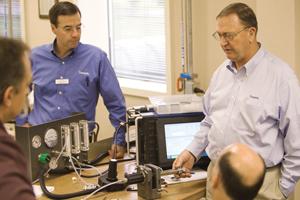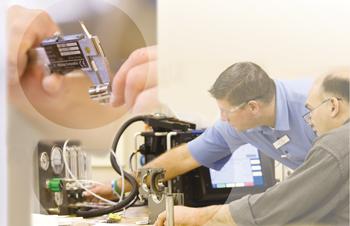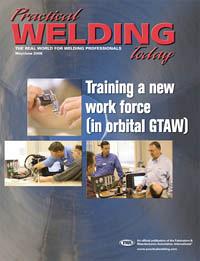- FMA
- The Fabricator
- FABTECH
- Canadian Metalworking
Categories
- Additive Manufacturing
- Aluminum Welding
- Arc Welding
- Assembly and Joining
- Automation and Robotics
- Bending and Forming
- Consumables
- Cutting and Weld Prep
- Electric Vehicles
- En Español
- Finishing
- Hydroforming
- Laser Cutting
- Laser Welding
- Machining
- Manufacturing Software
- Materials Handling
- Metals/Materials
- Oxyfuel Cutting
- Plasma Cutting
- Power Tools
- Punching and Other Holemaking
- Roll Forming
- Safety
- Sawing
- Shearing
- Shop Management
- Testing and Measuring
- Tube and Pipe Fabrication
- Tube and Pipe Production
- Waterjet Cutting
Industry Directory
Webcasts
Podcasts
FAB 40
Advertise
Subscribe
Account Login
Search
Automation training for a new work force
What to look for in an orbital welding training program
- By Ernest A. Benway
- May 13, 2008
- Article
- Arc Welding
Finding skilled welders is becoming difficult and will only become more difficult in the near future. According to the American Welding Society (AWS), more than 500,000 welders are employed in the U.S., not enough to meet the increasing demands of industry. Also, more than half of the existing work force is approaching retirement. AWS predicts that by 2010, the demand for skilled welders will outstrip supply by 200,000.
One way to address the shortage is through automated systems, which produce more work with fewer people. Since its introduction to the aerospace industry in the 1960s, automatic orbital gas tungsten arc welding (GTAW) has gained favor in a variety of industries in which maximum leak integrity, high performance, or ultracleanliness is important. Automated welding, however, does not diminish the requirement for an educated and well-trained work force. Just because a machine is automatic doesn't mean it is automatically right. Arguably, automation requires more training, not less.
You still must possess all the basic knowledge concerning material composition and metallurgy, setup, purge and shielding gases, power and voltages, weld pool dynamics, electrode size, and tip configurations. But you must also understand how the automated welding system operates and how it will react to different inputs, as well as which documentation is required from material suppliers and how to read and evaluate it. Proper training in the process, tools, and materials involved in orbital welding will make you an asset on any job site and help the industry benefit from automated welding technology.
Selecting a Training Program
In selecting a program, look for technical specificity and detail, as well as hands-on learning. First you should review the training materials and evaluate their quality. Are they good reference documents that you could find useful for years to come? Will they educate you in the rudiments, as well as prepare you for imperfect situations, when, say, the material composition of the two metals being welded is not the same? After a weeklong training program, you should be able to answer even difficult questions, such as:
- How do I purge a system thoroughly, and what calculations are involved?
- What are the consequences over time of using power levels in excess of those recommended?
- How do I compensate for differences in the composition of the two metals to be welded?
The level of the instructor's expertise is as important as the content in a training program. Search out programs taught by certified welding instructors. Training programs that do not provide sufficient depth or certified instructors only cost the shop money in the long run.
The GTAW Process
The major variables in GTAW should be covered in an orbital welding training program. Arc current levels, for example, control weld penetrations; travel speed affects both the width and the penetration of the weld; arc voltage, or the voltage drop measured across the tungsten electrode arc, is primarily affected by the arc gap, the type and purity of the shielding gas, the shape of the tungsten electrode tip, and the arc current input.
Training programs also should provide in-depth coverage of power supplies to prepare you for the equipment you will be expected to master on the job. The goal of automatic welding is to produce accurate and repeatable weld current levels during each weld cycle. To accomplish this, GTAW power supplies use a constant-current design. A constant-current (CC) power supply maintains the desired output current level, regardless of load conditions. In addition, new designs have improved the performance of inverter CC power supplies and have made them popular for both shop and field GTAW applications.
You also should learn about direct-current electrode negative (DCEN), which provides deeper weld penetration than direct-current electrode positive (DCEP). DCEN is the most common configuration used in GTAW for base metals other than aluminum and magnesium.
Orbital Welding Tools
When evaluating training programs, be sure to look at the amount of instruction devoted to shielding gases and purging. Good programs will teach you how shielding gases, directed to the arc and weld pool, protect the electrode and the molten weld metal from atmospheric contamination.
The chief factor influencing shielding gas effectiveness is gas density. Argon, which is 1.33 times the density of air, effectively covers the weld area and displaces the atmosphere. Helium has less density and tends to rise instead of flowing to the work area. To produce equivalent shielding, the flow of helium must be two or three times the flow of argon.

Choose a training program that is hands-on and provides quality training materials for future reference.
More power (heat) is delivered to the workpiece using helium compared to using argon. This is an example of how shielding gases can have a direct effect on the voltage-current relationship between the tungsten electrode and the work. For equivalent arc lengths and weld current, the arc voltage obtained with helium is appreciably higher than achieved with argon. Higher arc voltage means more power.
Having the knowledge to make a proper judgment in the choice of shielding gas is critical. Shielding gases can affect the metallurgical properties of some materials. Generally, the arc is quieter and more stable when shielded by argon rather than other gases. The lower unit costs and lower flow rate requirements of argon make it the preferred choice.
The success of orbital welding jobs can be greatly affected by using purging techniques. Many experienced welders fail to understand the importance of this basic concept. Some people in the welding industry consider purging to be the Achilles' heel of welding. Training programs must teach the principles of purging, including how to calculate purge time.
Proper selection of purge gas, typically argon, is the first step to successful purging. Argon is available in varying levels of purity, and learning the proper level for the desired result is essential. Defining and setting the correct flow and pressure through the tubing or piping and across the weld joint is one of the most important procedural steps you can take to ensure successful welding. Conversely, it is one of the most likely areas for problems if not properly handled. Purging done incorrectly or not at all can ruin entire manufacturing systems. The internal pressure helps keep the weld bead flush to the inside wall surface of the components being welded, while the proper flow helps keep the heat-affected zone clean.
You should learn about electrode sizes and current capacities, tip configurations, grinding, contamination, and replacement, ensuring proper use of orbital welding tools.
Quality Materials
Quality welds start with the material. Even the best orbital welding system can't compensate for poor material used to manufacture tubing, fittings, and other components. Selecting the appropriate material is the critical first step. Look for orbital welding training that addresses the main material families—including carbon and alloy steels, nickel alloys, refractory and reactive metals, and stainless steels—and that teach how to inspect all incoming materials and material certifications and assess the documentation.
Effective training in materials should address issues related to composition and metallurgy, including how sulfur content affects weld quality. These composition changes can result in welds that do not meet specification. Certain metals should be gas tungsten arc welded, as opposed to one of the other major welding processes, because GTAW provides the greatest protection against atmospheric contamination.
For carbon and alloy steels, the quality of gas tungsten arc welds is highly influenced by the base metal impurity content, such as the trace amounts of sulfur, phosphorus, and oxygen. Hydrogen embrittlement of these alloys is a problem if hydrocarbons or water vapor contamination is present. Nickel alloys can be more difficult to weld because of their susceptibility to cracking.
GTAW is the most extensively used welding process for joining refractory and reactive metals. Refractory metals, such as molybdenum and tantalum, and reactive metals, such as titanium and zirconium, are readily oxidized at elevated temperatures unless protected by an inert gas cover. For these metals and alloys, GTAW provides a high concentration of heat, control over heat input, and quality inert gas shielding.
Another major factor in GTAW is the sulfur content of the materials. The level of sulfur can change the surface tension of the weld puddle, affecting the heat flow into the puddle and the penetration characteristics of the material. Standard 316L, used in most general industrial welding applications, has typical sulfur levels in the range of 0.015 to 0.025 percent by weight. This material exhibits good machining and welding characteristics and requires less heat input to reach a set penetration depth. A greater number of high-purity industries require much lower sulfur levels—in the range of 0.003 to 0.01 percent by weight—and these materials produce different weld characteristics than materials with higher sulfur content. Training programs should teach the techniques for welding stainless steels with various sulfur levels.
It's especially critical that you learn the importance of the sulfur differential between the components to be welded. Attempting to weld components with significantly different sulfur content will likely produce a bead shift toward the component with the lower sulfur content, potentially causing the weld bead to partially miss the joint.
Only through quality training taught by certified instructors can operators of orbital welding equipment gain the complex skills, those beyond making connections and performing welds, needed to meet the strict acceptance criteria in today's welding environment.
About the Author
Ernest A. Benway
31500 Aurora Road
Solon, OH 44139
440-349-5934
About the Publication
subscribe now

The Welder, formerly known as Practical Welding Today, is a showcase of the real people who make the products we use and work with every day. This magazine has served the welding community in North America well for more than 20 years.
start your free subscription- Stay connected from anywhere

Easily access valuable industry resources now with full access to the digital edition of The Fabricator.

Easily access valuable industry resources now with full access to the digital edition of The Welder.

Easily access valuable industry resources now with full access to the digital edition of The Tube and Pipe Journal.
- Podcasting
- Podcast:
- The Fabricator Podcast
- Published:
- 04/16/2024
- Running Time:
- 63:29
In this episode of The Fabricator Podcast, Caleb Chamberlain, co-founder and CEO of OSH Cut, discusses his company’s...
- Industry Events
16th Annual Safety Conference
- April 30 - May 1, 2024
- Elgin,
Pipe and Tube Conference
- May 21 - 22, 2024
- Omaha, NE
World-Class Roll Forming Workshop
- June 5 - 6, 2024
- Louisville, KY
Advanced Laser Application Workshop
- June 25 - 27, 2024
- Novi, MI
































